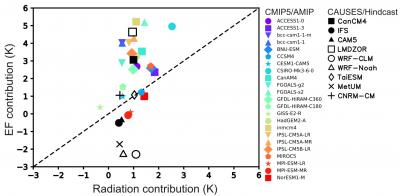CAUSES: On the Role of Surface Energy Budget Errors to the Warm Surface Air Temperature Error Over the Central United States
Scientists at Lawrence Livermore National Laboratory within the Atmospheric, Earth, and Energy Division, along with collaborators from the U.K. Met Office and other modeling centers around the world, organized an international multi-model intercomparison project, name CAUSES (Clouds Above the United States and Errors at the Surface), to identify possible causes for the large warm surface air temperature bias seen in many weather forecast and climate model simulations. Large warm bias can hinder models’ fidelity of climate simulations and their future projections.
As one of a series of papers to address several relevant contributors to surface air temperature bias from the project, this study identifies the relative importance of surface energy budget biases in causing the temperature bias. This allows model developers to target specific processes in causing errors in the surface energy budget within the atmospheric or land model component for improvement.
Through utilizing the measurements collected from the U.S. DOE ARM’s SGP sites and other available sources, this study shows that all participating models simulate too much net shortwave and longwave fluxes at the surface but with no consistent mean bias sign in turbulent fluxes over the Central U.S. and SGP. Nevertheless, biases in the net shortwave and downward longwave fluxes, as well as surface evaporative fraction (EF) are contributors to the temperature bias. Radiation biases are largely affected by cloud simulations, while EF bias is largely affected by soil moisture modulated by seasonal accumulated precipitation and evaporation. An approximate equation based upon the surface energy budget is derived to further quantify the magnitudes of radiation and EF contributions to the surface air temperature bias. The analysis ascribes that a large EF underestimate is the dominant source of error in all models with a large positive temperature bias, whereas an EF overestimate compensates for an excess of absorbed shortwave radiation in nearly all the models with the smallest temperature bias.

